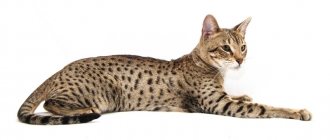It just so happens that 80% of cats hate bathing, and 20% are forced to endure it. It is believed that sphinxes, bobtails, Abyssinians and representatives of some other breeds are loyal to water procedures, and other cats try to escape by scratching and biting the owner. Unfortunately, cats themselves are not able to cope with all the pollution; sometimes they need to be bathed. However, you should try to turn this procedure into a game in order to eliminate battle scars in humans and reduce the possibility of stress in your pet to zero.
Why are many people afraid of water?
Cats are afraid to bathe not because of a specific nature, but out of instinctive fear. Zoologists have come to the conclusion that representatives of the cat family refuse water procedures for completely rational reasons:
- Risk of overheating or hypothermia. There is an air gap between the pet's fur coat and the skin, which allows you to adjust the temperature. Wet wool loses this property and is unable to protect the animal from either heat or cold. Felines do not know how to quickly cool down or warm up, they do not shake themselves off after bathing and do not travel long distances to dry out while moving.
- No camouflage. Wet wool emits a pungent odor, which is associated with an increase in body temperature as it dries. The cat will not be able to hunt, since the rodent will hear the smell of a predator from afar and will hide or avoid the dangerous place. In this case, the procedure is tantamount to an unsuccessful hunt and subsequent hunger.
- Fear of a sudden attack. Cats are afraid that during water procedures they may be attacked by predators or large birds. In water, a small animal is vulnerable, and on land, the danger increases due to the increasing odor emanating from wet fur. In addition, the cat concentrates heavily on licking its fur coat, so it may not hear the attacker.
Pets resist bathing because their fur quickly gets wet and shampoo dries out their skin. In nature, a wild cat will decide to get into the water just to save its life. Tigers and other large felines are an exception: they tolerate water treatments normally due to the water-repellent properties of their fur and the ability to shake themselves off.
How does sterilization affect aggressive, constantly screaming Bengals?
The genetic wildness of Bengal cats sharpens their natural instincts, bringing cats during periods of heat to heart-rending screams, displaying their “charms” for everyone to see, rolling on the floor, leaving marks in the most unsuitable places. Cats, sensing a partner nearby who is ready for anything, behave in exactly the same way. In addition, the smell of urine from an uncastrated Bengal cat is much more unpleasant and pungent. Hormonal surges in cats have nothing to do with love or just sex. The pleasure a cat receives during the mating process is questionable. Cats perform their ritual solely by virtue of natural instincts, without feeling any emotions towards the “lady of their heart”. Competent breeders of Bengal cats, when passing them on as regular pets, prefer to do this after sterilization. Putting aside the ethical side, sterilizing a Bengal has several weighty arguments in favor:
— contrary to popular belief, sterilized animals live longer;
- they are less susceptible to diseases of the genitourinary system and tumor diseases;
— the absence of sexual instincts brings them closer to their owners, making Bengal cats more affectionate and calm;
— the risk of losing your pet, who ran off into the street “in search of adventure,” is reduced;
— proper care and nutrition of sterilized Bengals does not affect their activity and love of life;
— sterilization of pets helps to avoid scent marks.
How to bathe a kitten so that it is not afraid?
To accustom your pet to bathing, it is better to start procedures from an early age. At 2 months, the baby can be bathed for the first time (without using shampoo), but veterinarians advise postponing this manipulation until 4 months. Bathing a very tiny baby will wash away the postpartum lubricant that protects it from infections. It can also interrupt the kitten’s natural scent, and the cat will refuse it.
At 3–4 months, as a rule, the baby is separated from his mother, so he can more easily endure the stress of immersion in water. Not every animal can get used to being washed, but the owner must be patient and follow the basic recommendations:
- Introduce the kitten to the basin - it should not cause him fear. The baby should be placed in the container before pouring water into it. Let your pet sit in it, smell it, and get used to it.
- The animal is taken out of the basin, water is poured at a temperature of 38–40°C to a depth of 5–7 cm. The pet is placed in water, held tightly by hand and talked to in a calm, even voice.
- The kitten's head is quickly wetted, making sure that the liquid does not get into the ears and nose. The shampoo is thoroughly washed off, since its residue on the fur can harm the animal. The procedure time should be kept to a minimum. During the process, the pet is petted to calm it down.
Description of the breed
The “mother” of this unique breed is the American geneticist Jig Sugden, who, during a trip to South Asia in 1961, acquired a wild Bengal cat and took it home. Only in 1982 did she manage to obtain stable hybrids of wild Asian cats and domestic cats.
Well, the official year of birth of Bengals is considered to be 1991, when the international standard for cats of this breed was approved, combining the color and swiftness of wild leopards with the docileness of ordinary domestic cats. According to this standard, an adult (over 2 years old) Bengal cat has the following characteristics:
- the body weight of these animals is usually from 5 to 6 kg;
- the height of Bengals at the withers ranges between 25 and 32 cm;
- the life expectancy of such a pet will be from 12 to 15 years;
- the body of these animals should be muscular and stretched;
- The length of the Bengals' hind legs should be greater than those of the front ones;
- the neck should be long and thick;
- the head is small in size relative to the body, wedge-shaped and has rounded contours;
- the eyes should be a rich green or golden color (blue is allowed for colorpoints) and have an oval shape;
- the nose of these cats is quite wide;
- the ears should be located at the edges of the head and have a relatively short length, be widened towards the base, and also have rounded tips;
- The cheeks of this breed are relatively plump, and the cheeks are quite massive.
One of the important characteristics is the color, in which the main tone is usually different shades of brown. There are also Bengals, whose color is dominated by snow, blue, charcoal and even silver tones. Regardless of the base color, all Bengals always have a pattern, which can be:
- marble;
- spotted (a la leopard);
- rosette (spots with darker edges).
The color of the design is usually black, gray or brown, and the design is always darker than the main tone. Any white spots on the coat are considered a defect; such kittens from professional breeders are subject to culling. The color of the tail can be spotted or ringed, and the tip of the tail must be dark. Regardless of the color option, all cats of this breed are distinguished by the presence of thick, soft and shiny fur.
The length of the coat varies between short and medium. Finally, the voice of Bengals differs from most classical breeds - it is noticeably louder, it has many more sound shades.
How to teach an adult animal to take a bath?
Sometimes an adult animal has to be taught to wash, for example, if a person takes in a stray cat. This is a difficult process, since the new ward has already formed a character, and water procedures will be new to him. In this case, you need to try to switch your pet’s attention from the water to something interesting. You need to gradually teach your animal to bathe without stress for him and the owner:
- If the cat does not want to be in the bathroom, he should be taught to go there willingly with the help of treats and toys. The same is done when an animal does not like the sound of water flowing from the tap.
- You also need to train your pet to be calm in the bathing container using toys and games. To begin with, it is better not to pour water into it or add it to a level of 1–2 cm.
- To keep the cat stable and comfortable, place a rubber mat or towel on the bottom of the bathtub or basin.
- It is important to ensure that the pet can freely leave the bathing container at will. This will make him more confident and not feel trapped.
- It is necessary to observe what objects or actions accompanying bathing cause aversion in the animal. They need to be excluded or the pet must be forced to gradually get used to them.
- The pet should be praised, petted and encouraged for showing interest in playing in the water or staying in the bath.
- An important factor in creating favorable conditions for swimming is good lighting. Lack of light can cause further stress.
Feeding
Bengal cats are carnivores, they are neither omnivores nor herbivores. Over the years, cat owners have forgotten about this fact.
If you look at commercial foods, you will see that they are low in meat and high in corn, soy, wheat, rice, and potatoes.
Since these types of cat food are only 50-60 years old, it is unlikely that they would have time to turn into omnivores.
So, why do they contain so many plant components?
The answer is simple: they are cheap .
- Do these foods provide enough for the cat to survive? Yes.
- Do these foods provide enough for a cat to thrive? No.
- What are the alternatives to commercial feed? Natural feed, meat and fish.
Just give your cat more natural food.
It is surprising when the owners are perplexed.
How? Only meat? And raw too? Yes.
What could be more natural for her? Or did you think that for the previous 9000 years cats ate exclusively canned food and dry food?
What should you not do when accustoming your pet to water?
Some actions of the owners can lead to the animal becoming stressed from bathing and subsequent attempts at washing will become impossible. The main mistakes when accustoming a cat to water procedures:
- It is not recommended to wash the kitten in the bathroom; it is better to use a basin. A small plastic container with low walls will be accepted normally by animals. When he sees the high sides of the bathtub and rising water, his instinctive fear of drowning turns on, so a small basin is preferable.
- Do not open the tap to full power or raise the shower head too high above the animal. Drops falling and scattering in all directions cause anxiety and discomfort.
- It is forbidden to plug your pet's ears with cotton wool, as it can cause irritation.
- Punching and screaming are the worst things you can use to restrain your pet. The cat will associate the procedure with pain and fear.
- You should not tie your cat while bathing. If she panics, she may hurt herself trying to jump out and get rid of the collar or leash.
- The animal should not be washed in too hot or cold water.
- The sooner the procedure is completed, the better.
Born to kill, survive, and fight for territory, wild cats were domesticated and experienced all the “charm” of civilized life. If you don't bathe your cat, will it be dirty? No, this is not a stupid question, think about it. Yes, a pet needs to be bathed when it gets into something that can be toxic when licked, “caught” parasites, before an exhibition, that’s all for valid reasons. How to accustom a cat to water, at what temperature to bathe and what to prepare for?
Health
Like all cats obtained from wild animals, Bengals are distinguished by enviable health and a life expectancy of up to 20 years.
They do not have the inherited genetic diseases that plague hybrid breeds.
Before purchasing, make sure your cat is F3-F4 generation, as the first generations are too wild cat-like and can be difficult to control.
It is difficult, if not impossible, to meet first-generation cats in our latitudes and you have nothing to worry about.
Why don't cats like water?
No, this is not a whim or character flaws, but an instinctive fear. In nature, a wild cat will go into the water based solely on survival instincts. There are exceptions, for example, tigers are swimmers and fishermen who can easily endure water procedures due to the water-repellent structure of their fur. It just so happens that more than 80% of domestic cats hate bathing, while the remaining 20% tolerate it. From the point of view of cat psychology, purrs do not like water because their fur quickly gets wet, and water, especially with shampoo, dries out delicate skin.
If you hope to “twist” your pet and bathe it “somehow”, give up the illusion; without washing the fur, you are risking the health of your ward. In addition, true fear provokes animals to desperate actions, fighting charms and torn clothes are provided to you, and after that, wet slippers and torn wallpaper as moral compensation for the “abuse”.
What does chirping mean?
Almost all cat breeds chirp.
There are several cat breeds that chirp much more and louder than other cat breeds.
One such cat breed is the Bengal cat.
Bengal cats make this cute sound frequently and much louder than most other cat breeds.
That's why I say:
Bengal cats are not ordinary cats. In fact, Bengal cats have many characteristics and requirements that other breeds do not have. For this purpose, if you have a Bengal cat, you should definitely check out our Bengal cat checklist.
Bengal cats make this sound frequently and louder because they are more vocal than other cat breeds.
The chirping of cats is directly related to their hunting instincts.
The fact that Bengals have stronger hunting instincts than most domestic cats explains why they often chirp.
All cats chirp, regardless of their breed or age.
Cat chirping is more of an "excited sound" that cats make than an actual sound used for hunting.
They make this sound when they spot something they think is prey.
Bengals often chirp when hunting birds or squirrels.
However, they can also chirp when they are in a frenzy over their toys and favorite food.
Sometimes Bengal cats also chirp with excitement when they meet their owners after a significant time has passed.
“Tactics” for training a cat to use the bathroom
Before teaching a cat not to be afraid of water, you need to overcome all the accompanying discomfort. Carry the animal into the bathroom in your arms; if the cat does not strain, try turning on the water for a short time. Calm your cat down, let him know that he is protected, but be prepared, the sound of running water can throw the cat into panic.
Try putting the animal in a dry bath; most likely, the pet will immediately run away, but this is only the first stage. Agree with your pet, do not try to wet the fur or force the cat not to be afraid, forcing events will only add to the hassle. Gradually, patiently, agreeing to the animal’s conditions and that’s the only way!
Important! Bathroom lighting is a separate issue. It has been established that animals experience fear if there is not enough light in the room. Change the light bulbs to brighter ones or install an additional light above the bathroom while you study.
Naturally, it is easier to accustom a kitten to water; the little one who unconditionally trusts you will accept or at least tolerate water procedures after 3-4 “training swims”. It is difficult, sometimes impossible, to train an adult cat. If your pet doesn't go outside, it's easier to give him a quick bath than to torment him for months of training.
Simple feeding rules:
- 80-85% meat (chicken, rabbit, beef, lamb, lamb, etc.)
- 10-15% edible bones (except tubular ones, such as chicken bones, let's give the neck, keel, joints)
- 5-10% tripe (various internal organs)
- cut into small pieces for kittens and larger pieces for adult cats
- always make sure that the meat is fresh, buy only from trusted sellers
- most cats prefer meat warm or at room temperature
- you can also give fish, eggs, kefir, cream and other foods that your cat loves
As for cat food, including dry food, you can feed it only, but such food will be far from what your pet needs.
Give a variety of food and your Bengal will grow big, beautiful and healthy.
Preparing for a swim
Half the success is quality preparation, especially when it comes to training an adult cat that has not yet experienced the “joys” of water procedures. You will need:
- 2 shallow but wide basins for water.
- Comb with large rounded teeth.
- Sponge.
- Capacity for pouring up to 250 ml in volume.
- Large bedspreads or sheets.
- Several thin ones and one bath towel.
- Gloves and thick clothing to protect the body.
- Water thermometer.
- Shampoo, if necessary.
- It’s very good if there is a “second pair of hands” to help.
Important! The cat should not be tied up while bathing. If your pet panics, he may hurt himself with the collar or leash.
How to teach a cat to bathe without unnecessary stress
- One of the basins is filled completely, the second so that the water barely covers the bottom. Water temperature 38.5–39 degrees.
- You and your assistant dress in ammunition and gloves. The bathroom floor is completely covered. Any “force majeure” will be accompanied by turmoil in which it is easy to slip.
- Carefully and slowly, holding the animal from above, lower the cat's paws into a basin without water. The animal will tense up and start shaking with its paws - we calm it down, pet it, hold it (there will be attempts to escape), do not try to sit it down or lay it down.
- After wetting the sponge with water, run it over the animal’s fur and calm the pet again.
- As a result, all the wool should be wet. The exception is the muzzle and ears. The second step is to lather the wool, if necessary.
- We comb the “fur coat” with a comb. In general, combing is necessary to remove foam if you use shampoo, but when training, we do not deviate from the algorithm.
- We pour the cat over from a small container several times.
- We blot the wool with thin towels and wrap it in a bath.
- Take your time, but don’t delay either, the procedure is not pleasant and the sooner it ends, the better.
- Repeat the procedure no more than once a month; even bathing with clean water partially washes off the protective layer of fat from the animal’s skin.
Note! The smell of catnip can help your pet relax, but don't get carried away! A surge of tenderness and calmness is associated with intoxication in the literal sense of the word.
A few words about exactly how to hold a cat. Your grip must be strong, because you will have to hold your pet with one hand. Grab the skin fold on the animal's withers, instinctively, the cat will calm down a little. Try to avoid the area under the belly - a convenient position for attacking with the hind legs.
If the animal panics, pick it up by holding it by the skin at the withers, wrap it in a towel and take it out of the bathroom. Even if there is foam left on the pet, act; the cat must be sure that you will come to the rescue at the right time. Remaining foam can be removed with a damp towel, but restoring trust is not so easy.
It so happened that a Bengal kitten appeared in our lives quite suddenly. They gave it to us. And we already had an adult cat of the Scottish breed.
What we immediately encountered was an unbearably loud meow, bordering on a howl and trips instead of a litter tray to the shower, the corner behind the toilet, and worst of all, to the sofa.
After a couple of days of staying with us, our new cat became friends with the Scottish one. And how, I began to perceive her as a mother.
We calmed down a little when the constant hissing of the house stopped. And she, in principle, began to go to the toilet, albeit with frequent mistakes. And this did not suit us.
We scoured the entire Internet and asked everyone we could. Everyone said the same thing: buy sprays, treat with lemon, change the filler (she just doesn’t like it), keep an eye on her. I should get used to it in two weeks. We did all this, but 2 weeks passed, three weeks, and for no reason at all she could go out of place again..
The last straw for us was when, after two days of good behavior, in the evening before bed after my unsuccessful attempts to put her on the tray, she went to the sofa. Right before our eyes, she just sat down and did it. We were terrified.
The first thing we decided was that it was just a stupid kitten and there was nothing we could do about it. “This is our first cat, she immediately went to her place as soon as she was brought in, she’s smart,” we reasoned and decided to return her back.
Well, isn’t it convenient to declare someone stupid by nature and stop all efforts?
However, we thought for a long time and with difficulty came to the conclusion that education is a process where it should be interesting to educate or re-educate those who need education, and not those who have already been raised and abandoned the kitten.
I’m still afraid to write that everything is fine, but now we are on the right track. And further, I want to share what helped us.
1) Lemon and vinegar are ineffective for treating areas that do not fit the toilet. As for sprays. It didn't help us. We took the “tray training” spray. It's just a solution of catnip. It’s better to buy citrus essential oil (with orange) and drip it where necessary (where you don’t need to go). The smell is pleasant and it works.
2) It’s really just necessary to monitor the kitten’s behavior and put it on the tray on time.
3) Buy dry food, more comfortable pads and give one pad for each correct trip to the tray. This turns out to work too. Ours now asks for a pad after the tray.
4) The most important thing is to be patient, most likely it will take you more than two weeks to get used to it. Perhaps even more than a month. Don't relax.
5) Where possible, after thoroughly washing with Domestos, place a bowl of food. Cats don't go to the toilet where they eat.
6) When your Bengal meows (howls), don’t be alarmed. If you are sure that the kitten is not hungry, just pick it up and pet it. Always do this in such cases. Believe me, the kitten will no longer bother you with its noise. Establishing a trusting relationship during litter box training is a very important thing.
7) Punishment, of course, is also an important element of education. Don't neglect it. If you are caught at the scene of a crime, punish him thoroughly.
 You should not lock your Bengal in the toilet. Most likely this will not lead to anything good. The Bengal will experience a lot of stress if left alone and will probably go crazy from the worries. On that fateful day when the sofa was damaged, we tried this closing method in the toilet.
You should not lock your Bengal in the toilet. Most likely this will not lead to anything good. The Bengal will experience a lot of stress if left alone and will probably go crazy from the worries. On that fateful day when the sofa was damaged, we tried this closing method in the toilet.
9) The place where the tray is located should be quiet, secluded and clean. Necessarily. No noises, especially unexpected ones, should disturb the kitten during this important task. We suspected that the kitten was forced to go to the sofa by the noise of the automatic air freshener.
10) And in general, if possible, when your kitten goes to the toilet, try to ensure silence throughout the house.))
11) About fillers. We have the cheapest wood. But the cat doesn’t touch him, he’s under the net. A lot has been written on the Internet about choosing a filler, “try everything.”
I do not understand this. If you still suffer and are trying to get used to it, then it is more logical to teach it in a way that is convenient for you. When a cat walks on the mesh, there is less dirt.)
12) Cats are not people, they have no human motives, they do nothing out of harm or spite.
In principle, raising a Bengal is practically no different from raising any other kitten. The only difference is in relation to water.
Any kitten can be litter trained, but how much effort and time it will require depends on what your kitten has already learned in the first weeks of life. Re-education is always more difficult and takes longer.
We ended up making friends with our Bengal, and no matter what happens, we are not going to back down).
- 31.05.2020
- 3 min. for reading
- 1.6K views
Content
- Maybe it's just kittens playing?
- Why are Bengals usually interested in water?
- How can I help my Bengal play safely in the water?
Despite the common idea that cats don't like water, many Bengal cat owners believe that their cats love to play in the water. This feeling of comfort in the water may come as a surprise to those who didn't expect it from their feline friend. Since this is a more common Bengal trait that is so uncommon in cats, let's take a closer look at it through the following topics:
- Maybe it's just kittens playing?
- Why are Bengals so interested in water?
- How can I help my Bengal play safely in the water?
Maybe it's just kittens playing?
Kittens do grow out of their strange habits as they get older, but more often than not, if a Bengal kitten likes water when young, this trait will continue as an adult. Bengals' interest in water is rarely just a kitten habit as they grow and the interest remains.
They rarely grow out of it, as some kittens with their strange features do. A Bengal kitten that loves to play in the water will likely continue to love the water when it reaches adulthood.
Why are Bengals usually interested in water?
Availability of fresh water is generally important for Bengals, and it can also prevent the pet from getting into trouble when seeking water from other sources. Bengals can still find their own water sources, such as a bathtub or kitchen sink, fountain, bathtub, or shower.
Cat fountains are especially useful when you live with a Bengal who loves to play in the water. Not only does it provide the cat with a source of water, but it also combines a place for Bengals to play in the water, so it's a real source of fun for cats.
Not all Bengals want to get wet or will be happy to find themselves in a bathtub of water, but many will manage to join their owner in the shower, dive into a water bowl, or check out their human's pool.
Bengal owners who enjoy water quickly cease to be surprised by their cat's love of water. We have many examples on our site of Bengals' interest in water, where they jump into the bath or shower with or without a person and put the lives of their fish brothers and sisters at risk.
However, an interest in water does not mean that Bengals will happily dive into a deep pool. But sticking their paw into a bowl of water and moving it around the surface is much more likely to show their interest in water.
This habit comes from the Asian Leopard Cat (ALC) in their ancestry. The Bengal cat does the same thing as ALC - sticking its paws into the pond and waving them around to clear the surface of dirt before drinking.
How can I help my Bengal play safely in the water?
Remember, just because Bengals may like water, it doesn't mean they need to be washed frequently!
The best way to care for your Bengal coat is by brushing it weekly to remove dead hair and skin, distributing oils throughout the coat. They rarely need to be bathed, even if they want to.
This doesn't mean you can't fill a bathtub or basin with water for some sparkler play. Simply pour a few inches of water into the bath when your Bengal has behaved well and has earned some treats or has too much pent-up energy that needs to be released.
It is also very important to maintain a hot bath if the Bengals in the house like to play in the water or in the bathtub. Making sure your Bengal cat can't get burned by hot water will save its owner a trip to the vet and an upset pet.
Making sure the toilet seat is down before leaving the bathroom will save the owner from having a wet, unhappy kitten fall into the toilet.
A Bengal kitten that shows an interest in water will likely continue this habit as it ages. So for most Bengals, if they are going to show an interest in water, it will start at a young age. Providing your Bengal kitten with options for safe water play from an early age can also help ensure an interest in water that will continue as the kitten gets older.
So, what do you think about Bengal kittens in the water? Do you agree with what has been said here? Leave a comment below to let us know!
Although Bengals are known for their friendly attitude towards people, they usually have a bright and not always easy-going character. Therefore, raising a Bengal cat kitten must begin in a timely manner. It is better for a new mini-leopard owner to learn this process before the pet arrives in its new home. An experienced breeder will take care to instill good habits, but they will have to be developed consistently.
How to raise a Bengal kitten
The socialization of the little Bengal begins almost from birth. He learns to interact with his mother cat and his brothers and sisters, equally inexperienced babies. After some time, people fall into his circle of interests. Experienced breeders perform a procedure called handling, accustoming baby Bengals to human hands.
The kitten is carefully and extremely carefully picked up and held for some time. Tactile sensations received at an early age are perceived by the pet as pleasant and natural. This is one of the reasons why purebred kittens react much calmer to human contact, unlike stray kittens.
A good tip on how to train a Bengal is to continue to handle it frequently with your new family. This practice will help you quickly make friends with your pet. Despite the presence of wild blood, Bengals are very friendly and sociable. If a kitten is raised correctly, a situation where it does not go to hand should not arise.
Description of the abilities and character of a Bengal kitten:
| Need for communication and attention | Very high |
| Attachment to the owner | High |
| Ability to get along with children | Very good |
| Ability to get along with other pets | Good, but there are problems with birds and rodents that become targets for hunting |
| Need for physical activity | High |
| Intelligence level | High |
| Relation to water | Usually very positive |
| Learning ability | Tall, can learn to fetch a toy and use the toilet |
The breeder knows how to raise a Bengal kitten. He will have to work hard to instill the right habits. The pet learns to eat solid food and drink from a bowl. He is being toilet trained. By three months, the animal is completely ready to move to a new home, but this does not mean that the new owner can relax and reap the benefits of upbringing that the new family member received earlier. We will have to solve several problems:
- prepare housing for the kitten's arrival;
- alleviate stress;
- maintain acquired skills;
- correct the kitten’s behavior;
- teach the kitten the “no” command.
The kitten grows, its behavior changes. There are stress factors that are not obvious to people, but are significant for a cat. We must not forget about temperament, which influences behavior. What to do in this case? Experienced breeders recommend continuing training; the results will appear over time.
Bengals are very musical cats. At an early age, they begin to sing and scream to express their feelings. If the owner is confident that the kitten is fed and healthy, it may simply need attention and comfort. To calm your pet, it is enough to pick him up, hold him, and warm him.
Character of the breed
Outwardly similar to small panthers, many traits in the Bengal's character were inherited from the habits of its wild ancestors:
- They are independent, freedom-loving, but very attached to their owner and show dog loyalty. They suffer from long separation.
- They do not like to lie in their arms for long periods of time; they climb onto their laps of their own accord when they want to pamper themselves.
- They quickly find contact with children and willingly participate in joint games and fun.
- They do not show aggression when the child accidentally or intentionally hurt the kitten. Just avoid the game and hide in a safe place.
- They do not show excessive communication or trust in unfamiliar people. It’s not easy for a stranger to stroke or caress them.
- They live freely, without conflicts, with other animals and inhabitants of the house.
- Playful and inquisitive, they love to climb cabinets, curtains, and sit on a hill.
- With affection and perseverance, Bengals can be trained, taught to use the toilet and flush the water from the tank.
- Representatives of the breed are successful hunters. There are no mice in the house where they live.
First days in a new house
A responsible owner begins preparing for the kitten's arrival in advance. Must have:
- bowls;
- toilet;
- feed;
- filler;
- house;
- cosmetical tools;
- grooming brush;
- toys;
- contacts of an experienced veterinarian;
- stocked first aid kit.
Young mini-leopards are inquisitive and nimble creatures. Even on the first floor, all windows must be covered with bars to prevent the pet from escaping. Cables of any kind must be hidden in boxes, under the baseboard, i.e. move away from the kitten as far as possible.
When a little Bengal is brought to a new home, the owner’s actions must be clear:
- Pour the food recommended by the breeder into a bowl.
- Pour fresh and clean water.
- Place litter in the toilet and add some old litter (obtained from a nursery) so that the kitten recognizes its smell.
- Place the carrier on the floor and open it.
- Move a reasonable distance away.
- Wait until the kitten leaves the carrier.
- Allow him to explore the house on his own.
- Make sure he eats and drinks from new bowls and goes to the toilet.
Only after this can you carefully approach the kitten, establish the first tactile contact, and try to stroke it. The desire to immediately grab your treasure, shower him with kisses, scratch him behind the ears is quite understandable. But such behavior can only scare the Bengal and increase stress.
Toilet problems: causes and solutions
Even if the adaptation process at a new place is carried out according to all the rules, this does not guarantee the absence of problems. Often the kitten refuses to use the litter box. An animal can choose a variety of places to perform its natural needs: a corner behind the toilet, surfaces covered with fabric (upholstered furniture), a shower tray.
If the pet chooses all unauthorized places for the sake of privacy, it means that using the existing tray causes discomfort or stress. Some purebred kittens prefer to use a toilet in the form of a house; an open litter box is not suitable for them. You need to purchase a new device, fill it and add some old litter from the previous tray so that the kitten can smell its own scent.
Sometimes the litter is not suitable for a Bengal cat baby. Many breeders recommend choosing woody or other “rustling” options for litter box training. Not all kittens like the helium version, although it is more convenient to use. One more thing - Bengals are amazingly clean. The filler must be replaced after each visit. Some owners provide the kitten with two litter boxes at the same time. To find the right filler, you will need to experiment.
Another reason why a kitten shits in the wrong place is the desire to mark territory. This is a character trait that will take a long time to fight, and success cannot be guaranteed. Experienced Bengal owners advise getting rid of upholstered furniture that does not have removable covers in advance, or purchasing such covers in advance. Medical mattress covers or other absorbent materials are placed under them to protect the furniture from getting wet.
It happens that an adult cat stops marking her territory and begins to use the litter box regularly, but then the problem arises again. The point may be that the animal has already marked everything it wanted. The owners washed the furniture from dirt and got rid of the characteristic smell. Weak cat vibes remain, the cat feels them, but the person does not.
Profile online communities are full of advice from experienced cat lovers, but their effectiveness may be questionable. Here are some interesting recommendations that helped to train a kitten to the toilet:
- lubricate areas prohibited for defecation with orange or lemon essential oil; cats do not like the smell of citrus fruits;
- use vinegar or a special spray for the same purposes;
- monitor the kitten and at the first sign put it in the tray;
- reward with a treat for each successful visit to the toilet;
- wash the “wrong” place with a cleaning agent, put food there, cats don’t shit in the places where they eat.
The result depends on the character of the particular kitten. Some people are so disgusted by the smell of bleach that they specifically go to a thoroughly washed place to get rid of the hated aroma. Others do not hesitate to relieve themselves on the rustling dry food. Many kittens love to rummage through the litter and scatter it around.
If you want to wean your kitten from this habit, you will have to be patient. The amount of filler is reduced very slowly, the process takes a year or two. The tactic does not always work; having lost the opportunity to rummage through its favorite litter, the kitten looks for a replacement. Often he uses the rustling surface of upholstered furniture to dig, and the struggle for adequate use of the tray has to begin again.
“If a cat begins to actively mark its territory, it would not hurt to consult a veterinarian. Sometimes these are not marks, but a sign of a developing disease.”
The reason for the violation of the procedure for using the litter box may be some change in the kitten's routine or other reasons. A kitten may poop in the wrong place after a visit to the veterinarian or another trip. This also often happens during estrus. Even rearranging furniture sometimes causes the problem to worsen. Don't worry, your pet will cope with stress and behave correctly again.
A cat’s own smell is equivalent to the signal “I’m safe at home.” If the signal weakens or disappears, the animal begins to worry. For example, a kitten becomes nervous due to sudden noise. There have been cases when the cause of stress was an automatic air freshener installed next to the tray. It works with a weak hiss, almost inaudible to a person, but the kitten is scared.
“Bengals are very smart. Many owners have managed to train them to use the toilet using a special plastic attachment.”
Nutritional Features
Most breeders advise feeding Bengal cats with ready-made professional food, dry or wet, but the pet should receive raw frozen meat (veal, rabbit or turkey) 1-2 times a week. You need to be careful with other products, especially dairy products.
Bengals have a weak stomach and intolerance to many foods, so it can be difficult to choose the right diet.
And yet, puzzled owners will ask what to feed a Bengal cat. If we talk about dry ready-made food, Royal Canin, Ekanubu and other high-quality manufactured products that your pet will like are excellent for adult representatives of the breed.
Different animals may like different foods, so you need to take your cat's preferences into account
When choosing products for pregnant or lactating cats, as well as kittens, make sure that there is a special mark on the packaging - “for kittens and lactating, pregnant cats”, “for kittens”. For example, Royal Canin 34 food is intended for kittens up to 4 months, although it can be given to a kitten up to 6-7 months without any harm to health. Sanabelle food for kittens and adolescents up to 1 year of age is also well received by little pets.
Additionally, Bengal cats, like many others, love wet cat food.
It is better to give food strictly in portions. Firstly, the regime is necessary for normal digestion. Secondly, Bengal cats often bury leftover food. Kittens are fed up to 5 times a day; teenagers - 3 times, and adult cats - 2 times a day. Clean drinking water should always be freely available. It's better in a large wide bowl that is difficult to turn over. An excellent option would be a special cat fountain.











